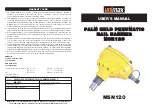
4
•
Before performing any maintenance, repair or adjustment, make sure that the device is disconnected from
the air supply.
•
It is strictly prohibited to aim the pneumatic hammer with inserted nail against persons or animals.
Compressed air
•
Dry and compressed air must have a defined pressure at the device's admission and must be supplied in
sufficient quantity. Higher pressure shortens the service life as a result of faster wear and tear and bears
the risk of injury.
•
The joint, through which the compressed air flows into the device, must correspond to the prescribed
dimensions.
•
Pay special attention to water, which damages tools when present. Do not forget to release the
condensed water from the pressure tank of the compressor on a daily basis and to also dry the hose,
which is used to supply the air into the tool.
•
Make sure no dirt may enter your device. It is necessary to keep inlet and outlet openings clean.
•
Before uncoupling compressed air piping or hose, wait until the pressure equalizes.
•
Before starting your work, inspect all couplings and piping for leakage. If leak is found repair it
immediately. Leakage overloads the compressor and causes significant increase in operational loads.
•
Inspect the pressure hoses and piping system regularly. If you discover damage or leak, stop working
immediately and have the defective house changed immediately. Pressurized hoses cannot be twisted.
Observe the line on the hose surface. Keep the line as straight as possible.
•
Do not run the pressure hoses over sharp edges or through places where they may be damaged or cut.
•
Blow compressed air through new hoses.
•
When you have to run the hose through a various structures, use protective bushing and inspect them
regularly.
•
Use protective covers or plugs to prevent dirt from entering the inside of your machine.
Power equipment
•
Before performing any maintenance make sure to lower the air pressure inside the air system down to the
atmospheric pressure.
•
If your machine is equipped with depressed springs, use a suitable device to release them slowly and
safely.
Hand tools
•
Never use vise to hold your tool/machine.
•
Make sure to have your work piece securely fastened. Use caution during manipulation and/or releasing
the work piece from the fastening device.
9
LIST OF PARTS
No.
Description
1
Screw
2
Cylinder cover
3
O-ring
4
Rubber sealing ring
5
Seal
6
O-ring
7
Friction casing
8
Sealing ring
9
Cylinder
10
Cylinder cover
11
O-ring
12
Piston
13
Piston rod
14
O-ring
15
Stopper
16
Casing
17
Body
18
Speed clutch piece
19
Washer
20
Spring
21
Guide
22
Magnet
23
Guide bushings
























